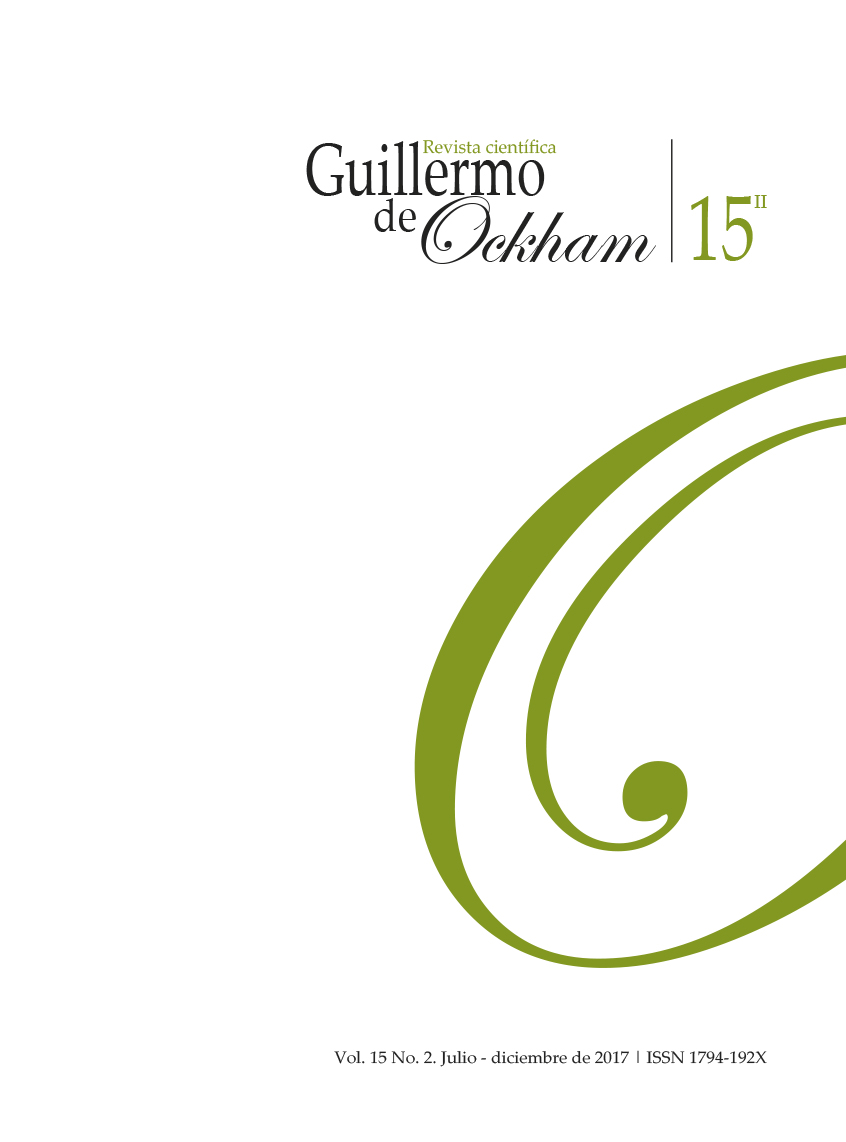The Revista Guillermo de Ockham provides an immediate and open access to its content, based on the principle of offering the public a free access to investigations to provide a global interchange of knowledge.
Unless otherwise established, the contents of this journal has a license with Creative Commons Attribution-NonCommercial-NoDerivatives 4.0 International (CC BY-NC-ND 4.0) http://creativecommons.org/licenses/by-nc-nd/4.0/
- Attribution: You must give appropriate credit, provide a link to the license, and indicate if changes were made. You may do so in any reasonable manner, but not in any way that suggests the licensor endorses you or your use.
- NonCommercial: You may not use the material for commercial purposes.
- NoDerivatives: If you remix, transform, or build upon the material, you may not distribute the modified material.
- No additional restrictions: You may not apply legal terms or technological measures that legally restrict others from doing anything the license permits.
Abstract
Si hay una cuestión por la que será evaluada la universidad del siglo XXI es por la implementación de los sistemas de acreditación de sus planes y programas, sumado a las áreas de desarrollo, entiéndase: docencia, gestión institucional, vinculación con el medio e investigación. Por otra parte, la expansión del postgrado y el incremento de las publicaciones científicas han modificado las cargas y tiempos de trabajo de los académicos (Conceição, Pastore, Aparecida, Barros, Silva, & Eleutério, 2015; Du, Lai, & Ló, 2010).
References
Alice Collaboration. (2013). Lon√g-range angular correlations on the near and away side in p–Pb collisions at sNN = 5.02 TeV. Physics Letters B, 719, 29-41.
Allik, J. (2013). Bibliometric analysis of the Journal of Cross-Cultural Psychology during the first ten years of the new millennium. Journal of Cross-Cultural Psychology, 44, 657-667. https://doi.org/10.1177/0022022112461941
Ardanuy, J. (2012). Breve introducción a la bibliometría. Barcelona: Universidad de Barcelona.
Clarivate Analytics. (2018). Back to the future: Institute for Scientific Information re-established within clarivate analytics. Extraído de: https://clarivate.com/blog/news/back-future-institute-scientific-information-re-established-within-clarivate-analytics/ 29 de marzo, 2018.
Conceição, R., Pastore, A., Aparecida, M., Barros, S., Silva, J., & Eleuterio, A. (2015). Mental disorders and stress factors at work among health área professors. Trabalho, Educação e Saúde, 13(1), 135-155.
Copiello, C., & Bonnifaci, P. (2017). A few remarks on Research Gate Score and academic reputation. Scientometrics, 114(1), 301-306. Doi: 10.1007/s11192-017-2582-9
Du, P., Lai, L., & Lo, N.M.K. (2010). Analysis of job satisfaction of university professors from nine chinese universities. Frontiers of Education in China, 5(3), 430-449. Doi: 10.1007/s11516-010-0109-8
Garfield, E. (1955). Citation indexes for science: A new dimension in documentation through association of ideas. Science, 122(3159), 108-111. Doi: 10.1126/science.122.3159.108v
Lawani, S.M. (1977). Citations analysis and the quality of Scientific Productivity. BioScience, 27(1), 26-31.
Lotka, A.J. (1926). The frequency distribution of scientific productivity. Journal of the Washington Academy of Sciences. 16(12), 317-323.
Orduña-Malea, E., Martín-Martín, A., & Delgado-López-Cozar, E. (2016). La bibliometría que viene: Almetrics (Author-Level Metrics) y las múltiples caras del impacto de un autor. El Profesional de la Información, 25(3), 485-496.
Price, D.J. (1951). Quantitative measures of the development of science. Archives Internationales d histoire des sciences, 14, 86-93.
Price, D.J. (1963). Hacia una ciencia de la ciencia. Barcelona: Ariel.
Salas, G., Ponce, F., Méndez-Bustos, P., Vega-Arce, M., Pérez, M.A., López-López, W., & Cárcamo Vásquez, H. (2017). 25 años de Psykhe. Un análisis bibliométrico. Psykhe, 26(1), 1-17. Doi: 10.7764/ psykhe.26.1.1205
Sánchez, V. (2016). El fenómeno de los artículos con muchos autores. Extraído de http://newsnet.conacytprensa.mx/index.php/documentos/12817-el-feno-meno-de-los-arti-culos-con-muchos-autores 28 de marzo, 2017.
Subramanyam, K. (1983). Bibliometrics studies of research collaboration: A review. Journal of Information Science, 6(1), 33-38.
Urbizagástegui, R. (2005). La productividad científica de los autores. Un modelo de aplicación de la ley de Lotka por el método del poder inverso generalizado. Información, Cultura y Sociedad, 12, 51-73.
































